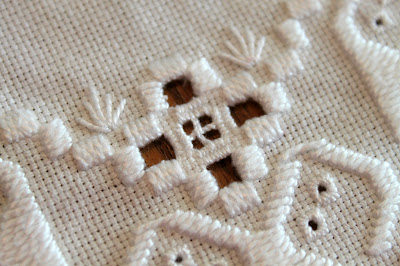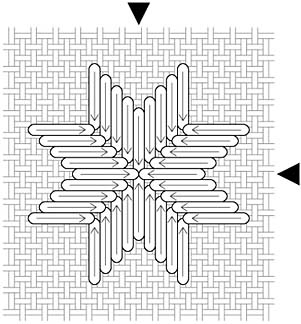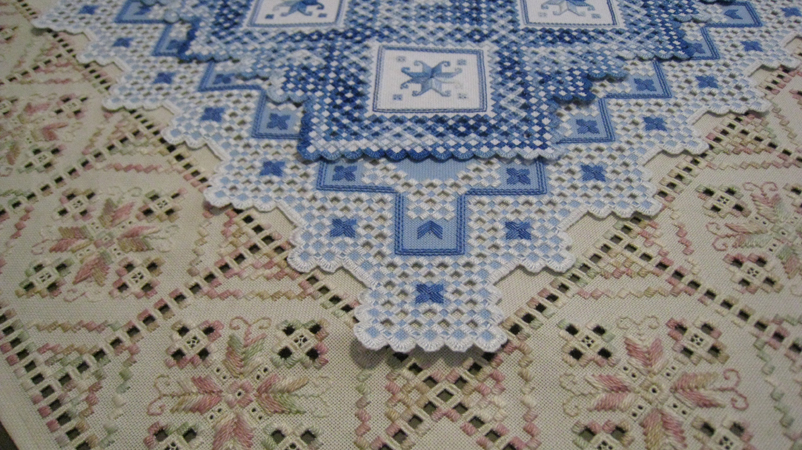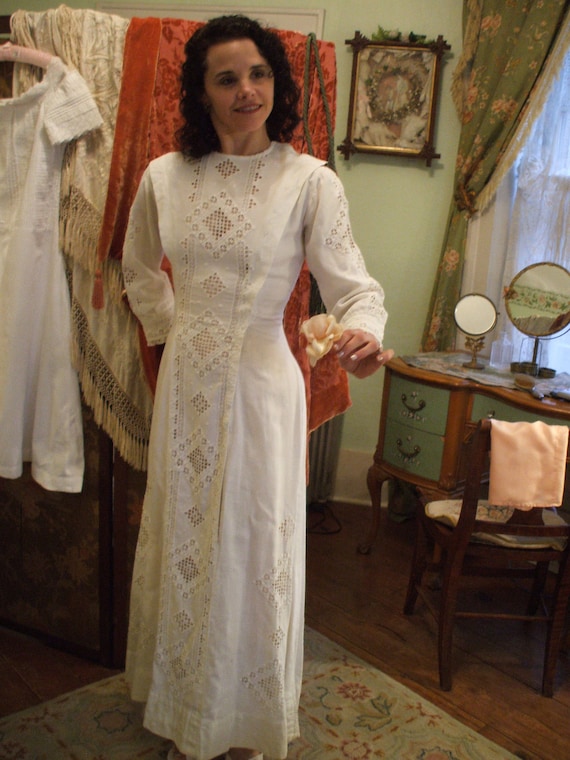I am SOOOOO excited to have my first guest blogger today! I'm sure you'll come to appreciate our guest's skill and knowledge about Hardanger embroidery but I already have unlimited love and appreciation for her because she's my momma! So, go Momma!
If you are looking for a type of needlework that is light weight, easily transported, requires only a few basic supplies, is done with a few basic stitches and can be adapted for several different uses, Hardanger Embroidery maybe just the thing for you. It may look a bit intimidating but if you can be patient and can count, you can quickly master this art form. Well, I have to admit that being a bit of a perfectionist helps.
There is no definitive history of Hardanger Embroidery although it may have roots back in ancient Persia and Asia. Some of the motifs look similar even to early Egyptian and Assyrian stitches and patterns. There are similarities to some of the early Italian handwork, so it has a long ‘bloodline’. Like so many other things, it just developed, taking on a life of its own.
 |
Stalheim Hotel and Naerodalen, Hardanger Fjord, Norway
Image via Old Picture
|
 |
| Trolltunga (Troll's Tungue), Hardangerfjord, Norway. Image via Hardangerfjiord.com |
 |
| Image via Visobservatories |
The distinctive style we know today as Hardanger Embroidery was developed along the South Western coast of Norway in the Hardanger Fjord area beginning in the 16th century. This was an area geologically isolated by glacier-capped mountains and the North Sea so it had long been a sea faring community. Therefore there is a plausible theory that some of these hardy Vikings in their wide ranging explorations picked up some fabrics that had been decorated with needlework of various types. The men brought them home to their wives and the patterns caught the attention of the women of Hardanger. Over the next 200 years they developed and refined their own style of needlework. The local farmers grew their own flax to use in carding, spinning and weaving the needed threads and fabric. The natural white or off-white color of the linen set the traditional color scheme of white on white. Present day crafters are adding colors but the purists among us stay with the white. To me that’s a big part of the elegance of the work.
 |
| Hardanger Fjord Girl, wearing Bunad with Hardanger on apron. Image via WikiMedia Commons |
The Norwegians call it Hardangersom – “work from the Hardanger area”. In the beginning it was used only for the collars and cuffs on their folk costume, called ‘bunad’. And they made separate bands to be added to the white apron that in some locals was a part of the bunad. Later Hardanger was included into household linens. I’ve seen bedspreads and table clothes covered in this needlework. They are beautiful but I would find it hard to put it on a table with food.
 |
| Kloster blocks and satin stitches Needlework by Mom |
There are two basic stitches used predominantly; first is the satin stitch or Kloster block. This is a series of five stitches worked over four threads. They are put on in straight rows or at right angles to each other. The second most used stitch is the over-under woven bar used in the drawn thread spaces. These straight rows and right angles cause the overall piece to look somewhat geometrical and angular. The cutting for drawn work is never done until all Kloster blocks are in place. Then the decorative additional stitches go on to soften the overall look. Don’t let the cutting stop you from trying Hardanger. There are many pretty patterns that can be done without open cut work.
 |
Needlework by Mom, photo by Dad.
|
The few basic supplies needed include:
Fabric Since the square or rectangle becomes the basic principle of the design, the fabric used must be of even count, meaning the same number of threads per inch in both directions; warp (lengthwise) and woof (crosswise). There are many fabrics available that meet this standard but the most commonly used fabric today was developed specifically for this use with two threads running together each way but are treated as one thread. This is simply called Hardanger fabric and may have from 18-32 threads per inch, 22 count being the most popular.
Thread Two sizes of thread are needed; a larger thread for Kloster blocks, and a slightly smaller thread for the needle weaving and decorative stitches. 22 count fabric calls for size 8 & size 12 DMC floss.
Needles To match these threads you’ll need two sizes of needles; # 24 & #26 Tapestry needles with their blunt point so you don’t split the fabric threads.
Scissors This is a must : a pair of fine pointed, very sharp embroidery scissors (and it's a good idea to keep one pair just for the cutwork).
Tweezers May be helpful in pulling cut threads (and for correcting mistakes and there will some).
Magnifier If you are of a certain age this may be helpful – you’ll know if you need one – I do!
Patterns There are many available or you can design your own.
NO hoop or frames! A hoop will mostly get in the way and can stretch the fabric. Instead the applied threads are just carefully laid on to fit the tension of the fabric.
If you have stayed with me to read this far you must be interested so I suggest it’s time to go to the Internet to explore further. Simply type in Hardanger Embroidery. You’ll find more resources than you can ever use! My favorite is Nordic Needle. This is a shop in Fargo, ND and is the best source in the US I’ve found. These folks have anything you need from instructions, to patterns and supplies, to tips and more. I’ve called them for help over the phone and they are always patient and gracious with any help.
 |
| Image via Montana Arts Council |
If you have stayed with me to read this far you must be interested so I suggest it’s time to go to the Internet to explore further. Simply type in Hardanger Embroidery. You’ll find more resources than you can ever use! My favorite is Nordic Needle. This is a shop in Fargo, ND and is the best source in the US I’ve found. These folks have anything you need from instructions, to patterns and supplies, to tips and more. I’ve called them for help over the phone and they are always patient and gracious with any help.
If you decide you want to try Hardanger local needlework &/or yarn shops sometimes have books or classes. Some craft shops have Hardanger fabric in smaller pieces or maybe even instruction books. It’s worth a look. Fabric stores will also sometimes carry the Hardanger or Aida fabric on bolts in case you want to make a bedspread!
Two more things and then I’m done: The word Hardanger may be pronounced “Har dung a”, “Hard un ger” but “Hard anger” only if you have just found a mistake that must be rectified.
And - the word Hardanger is always capitalized because it can mean four different things:
- A location- Hardangerfjiord, Norway
- This type of embroidery
- The name of the fabric used to do Hardanger embroidery
- A specific type of violin that is unique to Norwegian music.
 |
| Hardanger Fiddle. Image via Wikipedia |
Happy stitching.
Is my mom great, or what? We once visited Little Norway just outside of Mount Horeb, Wisconsin and part of the tour of the house included a look at and discussion about Hardanger, which is everywhere at Little Norway. As we stood beside a bed covered with a gorgeous Hardanger bedspread, I heard my mom let out a little gasp. The docent glanced at mom and then said, "The tradition is that no piece of Hardanger should be perfect because only God is perfect. Can anyone find the imperfection on this bedspread?" Mom pointed to the corner of the spread with an altered pattern, which of course was correct but to be honest, I never did see the alteration in the pattern. So proud of my mom at that moment, even if I was a teenager!
This is a piece that mom made for me. It lives on my dining table under the fake peaches.
A hallmark of excellent needlework is the back of the piece. Go ahead, guess which side is the front...
Here is some of Mom's work in it's natural habitat:
OK, those of you who have been with me know that this is the point at which we go on tour. Let's tour Hardanger...
 |
| Table Runner. Image via e-broidery.com |
 |
| Instructions diagram for a traditional motif. Image via The Caron Collection |
 |
| Colored Hardanger tables centerpieces. Image via Gimletblog |
 |
| Coleus 1 by Shirley Kay worked on 22-count Hardanger and dyed with Dye-Na-Flow. Sorry Mom, I know this sort of non-traditional thing makes you faint. Image via Embroidered Fables |
 |
| Ringer Bearer's Pillow. Image via Stitching by A Cornish Sea Shore |
 |
| Welcome Tea Towel stitched by Becky Moore. Image via Nordic Needle This kit is available from Nordic Needle. Click here. |
 |
| 1900's Edwardian wedding dress. Image via Adanta3 on etsy. |
 |
| One of the patterns my mom has used. Actually, it's very easy to take part of one pattern and combine it with another. |
I was thinking while photographing some pieces, that an image like this would make a nice Christmas card. A sweet little Hardanger snowflake, a greeting in Norwegian...
Lyn's Fine Needlework has a nice selection of instructional books and Save The Stitches by Nordic Needle has a great section on Hardanger stitching techniques.
That's about it for today, a nice little meet and greet with Hardanger embroidery. A big huge thanks and a hug to my mom for sharing her skills with us. And of course, today's butterfly picture ...
 |
| Image via hoogwater-laagland |
Thanks for stopping by and have a great day.














thanks so much for this informative post. My aunt was over last night for supper and brought me a Hardanger tablecloth which was made by my Norwegian great great grandmother.
ReplyDeleteWhat great timing! I'm glad you were able to connect to your ancestry through your "new" tablecloth and I'm sure you'll come to treasure it deeply.
Delete